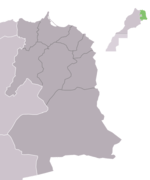Oujda
Oujda or Wejda (Berber: Wejda, ⵡⴻⵊⴸⴰ; Arabic: وجدة) is a major Moroccan city in its northeast near the border with Algeria.
Oujda Wejda / ⵡⴻⵊⴸⴰ (Berber) وجدة (Arabic) | |
|---|---|
City | |
| Other transcription(s) | |
| • Berber | Wejda |
| • Arabic | Wajda |
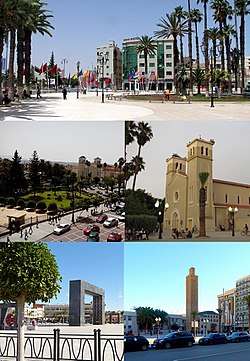 | |
 Flag 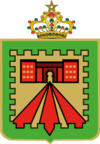 Coat of arms | |
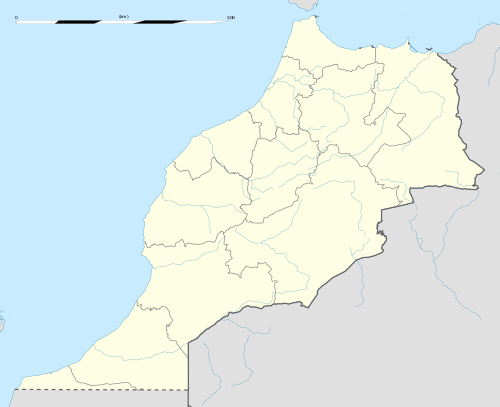 Oujda location of Oujda in Morocco | |
| Coordinates: 34°41′21″N 1°54′41″W | |
| Country | Morocco |
| Region | Oriental |
| Modern city | 994 |
| Area | |
| • Total | 96.4 km2 (37.2 sq mi) |
| Elevation | 470 m (1,540 ft) |
| Population | |
| • Total | 494,252 |
| • Rank | 8th in Morocco |
| • Density | 5,100/km2 (13,000/sq mi) |
| Time zone | UTC+0 (WET) |
| • Summer (DST) | UTC+1 (WEST) |
Wejda is the capital city of the Oriental region of northeastern Morocco and has a population of about 500,000 people. It is located about 15 kilometres (9 miles) west of the Moroccan-Algerian border and about 55 km (34 miles) south of the Mediterranean Sea coast.
History
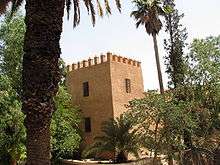
There is some evidence of a settlement during the Roman occupation, which seems to have been under the control of Berbers rather than Romans.[2]
The city was founded in 994 by Ziri ibn Atiyya, Berber chief of the Zenata Maghrawa tribe. Ziri was, with his tribe, authorised to occupy the region of Fas, but feeling insecure in that region and that town, and wishing to be nearer to the central Maghrib homeland of his tribe, he moved to Wajda, installed there a garrison and his possessions, appointing one of his relatives as governor. In the mid-11th century, a new quarter with a wall was allegedly added to the primitive core. Yusuf ibn Tashfin occupied the city in 1079, and in the next century, it came under Almohad control, with its fortifications repaired and strengthened under the Almohad caliph Muhammad al-Nasir.[3]
In the mid-11th century, Oujda acquired prominence through its strategic position on the road east from Sijilmasa. Throughout the history of the dynasties of the Muslim West, Oujda played an important strategic role among the Merinids, settled in Fes, in this case as a rear base in their conflict with the Abdalwadids of the Kingdom of Tlemcen.
The city was rebuilt in the 13th century by sultan Abu Yusuf Yaqub. The city experienced great difficulty in making peace with its neighbours to the east, and sometimes to the west, because of its position in respect to the clashes between the Saadi dynasty and the Ottomans of Algiers. It was torn between the rulers of Fes and the rulers of Tlemcen, and from the 16th century, it was contested by the Alaouite dynasty.
The French occupied it in 1844 and again in 1859. To the west of the city is the site of the Battle of Isly in 1844. In 1907 and 1908 Oujda was reconquered by General Bugeaud and Marshal Lyautey and used as a French military base to control eastern Morocco. The modern city owes much of its present form to the French, it developed along the roads built at that time.
The 1948 Anti-Jewish Riots in Oujda and Jerada[4] occurred in this city. The crowd, sparked off by a minor incident, poured into the Jewish quarter. In the three hours that passed before the army could control the mob, five people (including one Frenchman) had been killed, 30 had been severely injured, shops and homes had been sacked.[5]
The Moroccan border with Algeria is just east of Oujda; on the other side of the border is the Algerian town of Maghnia. The border has been closed since 1994.
In 2010, Rod Solaimani famously chronicled his trip to Oujda for MTV.
Geography
The city is located 60 km (37 mi) south of the Mediterranean sea and 15 km (9 mi) west of Algeria, with an estimated altitude of 450 metres (1,476 feet).
5 km (3 mi) south from city centre is located Jbel Hamra, a typical Mediterranean forest. Into the east of this forest is located Sidi Maafa park.
To the north of the city is the Rif area.
Climate
The city has a cold semi-arid climate (Köppen climate classification BSk). Rainfall is between 300 mm (11.8 in) and 500 mm (19.7 in) per year. It rarely snows in winter, the last snowfall was on 5 February 2012. Weather in Oujda is cool but still tepid and wet in winter, hot and dry in summer.
There is to say that Oujda is mostly hotter than other cities in Morocco. While in a day Casablanca has over 20 °C, Oujda can have over 30 °C.
| Climate data for Oujda (Oujda Airport) 1961–1990, extremes 1910–present | |||||||||||||
|---|---|---|---|---|---|---|---|---|---|---|---|---|---|
| Month | Jan | Feb | Mar | Apr | May | Jun | Jul | Aug | Sep | Oct | Nov | Dec | Year |
| Record high °C (°F) | 25.0 (77.0) |
33.0 (91.4) |
32.3 (90.1) |
35.0 (95.0) |
41.0 (105.8) |
44.0 (111.2) |
45.0 (113.0) |
45.0 (113.0) |
42.0 (107.6) |
37.0 (98.6) |
31.0 (87.8) |
26.0 (78.8) |
45.0 (113.0) |
| Average high °C (°F) | 15.7 (60.3) |
17.0 (62.6) |
18.7 (65.7) |
20.2 (68.4) |
23.8 (74.8) |
28.0 (82.4) |
32.7 (90.9) |
33.1 (91.6) |
29.9 (85.8) |
24.7 (76.5) |
19.8 (67.6) |
16.3 (61.3) |
23.3 (73.9) |
| Daily mean °C (°F) | 9.8 (49.6) |
11.0 (51.8) |
12.2 (54.0) |
13.8 (56.8) |
17.0 (62.6) |
20.9 (69.6) |
24.8 (76.6) |
25.2 (77.4) |
22.5 (72.5) |
18.0 (64.4) |
13.7 (56.7) |
10.5 (50.9) |
16.6 (61.9) |
| Average low °C (°F) | 3.9 (39.0) |
5.0 (41.0) |
5.8 (42.4) |
7.4 (45.3) |
10.1 (50.2) |
13.8 (56.8) |
16.8 (62.2) |
17.4 (63.3) |
15.1 (59.2) |
11.3 (52.3) |
7.6 (45.7) |
4.8 (40.6) |
9.9 (49.8) |
| Record low °C (°F) | −6.0 (21.2) |
−4.0 (24.8) |
−5.0 (23.0) |
−1.0 (30.2) |
1.0 (33.8) |
7.0 (44.6) |
10.0 (50.0) |
7.0 (44.6) |
5.0 (41.0) |
1.0 (33.8) |
0.0 (32.0) |
−6.0 (21.2) |
−6.0 (21.2) |
| Average precipitation mm (inches) | 31.0 (1.22) |
38.8 (1.53) |
44.8 (1.76) |
48.4 (1.91) |
39.0 (1.54) |
11.8 (0.46) |
2.2 (0.09) |
4.0 (0.16) |
10.0 (0.39) |
33.5 (1.32) |
37.8 (1.49) |
45.4 (1.79) |
347.7 (13.69) |
| Average precipitation days | 7.9 | 8.5 | 8.1 | 8.5 | 7.3 | 3.9 | 1.7 | 2.4 | 3.6 | 6.2 | 7.8 | 8.1 | 74.0 |
| Average relative humidity (%) (at 6:00 am) | 83 | 82 | 84 | 87 | 86 | 83 | 76 | 77 | 81 | 85 | 82 | 83 | 82 |
| Mean monthly sunshine hours | 188.6 | 184.7 | 229.3 | 239.9 | 281.5 | 308.5 | 336.6 | 311.3 | 261.6 | 242.4 | 194.4 | 185.9 | 2,964.7 |
| Source 1: NOAA[6] | |||||||||||||
| Source 2: Deutscher Wetterdienst (humidity, 1947–1976),[7] Meteo Climat (record highs and lows)[8] | |||||||||||||
Architecture
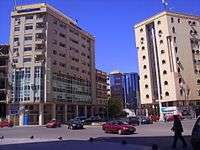
The main characteristic of the city is having the old city in the centre. The old city maintains traditional features of the Moroccan architecture with its narrow and twisted alleys which leads to the houses and different markets such as jewelry market and the leather market.
Bled el Gaada is a Roman era ruins just outside of Ouijda.[9][10] The ruins consist of a Roman Castra fort 175m by 210m.[11]
Music
Gharnati refers to a variety of music originating in Andalusia. Its name is related, being derived from the Arabic name of the Spanish city of Granada.
Gharnati constitutes the musical mode most used in the Moroccan city of Oujda, where besides this musical kind is omnipresent and where one organizes each year in June the International Festival of the Gharnati music. Oujda is also the destination of popular music raï.
Subdivisions
The province is divided administratively into the following:[12]
| Name | Geographic code | Type | Households | Population (2004) | Foreign population | Moroccan population | Notes |
|---|---|---|---|---|---|---|---|
| Bni Drar | 411.01.11. | Municipality | 1648 | 8919 | 57 | 8862 | |
| Naïma | 411.01.19. | Municipality | 218 | 1151 | 0 | 1151 | |
| Oujda | 411.01.23. | Municipality | 82128 | 400738 | 2700 | 398038 | |
| Ahl Angad | 411.07.01. | Rural commune | 2897 | 16494 | 113 | 16381 | |
| Ain Sfa | 411.07.03. | Rural commune | 837 | 5082 | 5 | 5077 | |
| Bni Khaled | 411.07.05. | Rural commune | 1231 | 7104 | 30 | 7074 | |
| Bsara | 411.07.07. | Rural commune | 317 | 1922 | 1 | 1921 | |
| Isly | 411.07.09. | Rural commune | 4262 | 23896 | 24 | 23872 | |
| Mestferki | 411.07.11. | Rural commune | 797 | 4832 | 0 | 4832 | |
| Sidi Boulenouar | 411.07.17. | Rural commune | 516 | 3526 | 0 | 3526 | |
| Sidi Moussa Lemhaya | 411.07.19. | Rural commune | 563 | 3436 | 0 | 3436 | |
Education
Oujda is known by the excellency of the inhabitant. Students in baccalaureate and engineering schools are known as the best in Morocco. Oujda is home to Mohammed the First University. This university is rated very well in Morocco. But, as at other universities in Morocco, R&D investment is very low. Lot of critics to the King Mohammed VI are raised, when it depends on education and medicine, especially investment on R&D. Oujda contains the Centre Hospitalier Universitaire Mohammed VI. Also it contains a public high school of engineering called ENSAO. Besides, it contains more private school like Supmti(it), hem, hbf.
Industry
Oujda has a cement works.
A techno-pole (Oujda Shore) is constructed near the airport.
Transport
The city is served by Angads Airport, which has connecting flights to Eindhoven, Brussels, Madrid, Marseille and Paris as well as domestic flights to Casablanca.
The city is the endpoint of the main railroad from Casablanca via Fes and Taourirt before the border with Algeria. There are several day and night trains to and from the city, linking it to the western part of the country.
Economy
Oujda has a strategic importance because of its location on the border. There are many economic and natural resources however, problems of overpopulation of the city and increase in unemployment rate up to 18% of the 11% on the national level. Migration to foreign countries was up to 28.3% of the national total.
Oujda relies heavily on trading because of its location between west of Algeria and east of Morocco. The economy of the city is directly related to the border's condition as it represents a passage for businesses directed towards Fes in the west, Talmasan in the east, Figuig in the south and Melilla in the north. As for the Industry in Oujda, the first mill was founded in 1928. The industry showed significant improvement during the seventies and eighties but was still humble compared to the industry of major Moroccan cities.
There are few touristic and historic locations such as Sidi Yahya's oasis. However, due to the lack of resources tourism does not contribute much to Oujda's economy. On 18 March 2003 king Muhammad the sixth has indicated to the importance of reviving the economy of the eastern area. In the context of this effort, Technopol Oujda was established. Other efforts such as road improvement, airport expansion and other project to improve the cities economy was founded.
Sport
The sports infrastructure in Oujda is composed of a municipal stadium, an Olympic venue, the Honneur Stadium of Oujda, built in 1976, the sports complex 'Rock' including a rugby stadium, a complex tennis in the park Lala Aicha, a golf course and two sports halls.
Football
The first football club to win the Throne Cup of Morocco was the Moloudia Club of Oujda (MCO) in 1957 after defeating the Wydad of Casablanca, in the next year MCO won his second and successive throne cup against the same club, in 1959 MCO was in his third successive final, but this time the club lost against the FAR of Rabat, the next year MCO played his fourth successive final against the FUS of Rabat and won the cup, in 1962 MCO won his last Throne cup against the Kawkab Athletic Club of Marrakech.[13]
After ten years, the Mouloudya of Oujda came back to win in 1972 the Maghreb Cup, three years after MCO won The Botola Pro of Morocco.[14]
There is also the USMO, the second most popular Football club in Oujda.
Town twinning
Since 2009, the city has been twinned with Trowbridge in England due to the huge number[15] of diasporans, most of whom originate from villages close to Oujda. Trowbridge has the largest Moroccan community in the UK outside London.








.svg.png)
See also
- Oujda group - an Algerian political faction named after the town
References
- "POPULATION LÉGALE DES RÉGIONS, PROVINCES, PRÉFECTURES, MUNICIPALITÉS, ARRONDISSEMENTS ET COMMUNES DU ROYAUME D'APRÈS LES RÉSULTATS DU RGPH 2014" (in Arabic and French). High Commission for Planning, Morocco. 8 April 2015. Retrieved 29 September 2017.
- Siraj, Ahmed (1 January 1995). L'image de la Tingitane: l'historiographie arabe médiévale et l'antiquité nord-africaine (in French). Boccard. pp. 589–595. ISBN 9782728303175.
- Marçais, G.; Troin, J.F. (2002). "Wad̲j̲da". In Bearman, P.; Bianquis, Th.; Bosworth, C.E.; van Donzel, E.; Heinrichs, W.P. (eds.). Encyclopaedia of Islam. XI (2nd ed.). Leiden, Netherlands: Brill Publishers. pp. 23–24. ISBN 9004081143.
- Andrew G. Bostom (2008). The legacy of Islamic antisemitism: from sacred texts to solemn history. Prometheus Books. p. 160. Retrieved 6 March 2011.
- Dalit Atrakchi (2001). "The Moroccan Nationalist Movement and Its Attitude toward Jews and Zionism". In Michael M. Laskier and Yaacov Lev. The Divergence of Judaism and Islam. University Press of Florida. p. 163.: "...the riots that broke out on 7 June 1948 in the cities of Oujda and Jerada, close to the border between Morocco and Algeria, which served as a transfer station for Moroccan Jews on their way to Israel... It is believed that the riots were brought on by the speech given a short while earlier by Sultan Muḥammad Ben-Yussuf, which inveighed against the Zionists and cried for solidarity with the Arabs fighting in Israel. Claims have been made that the French authorities not only knew about these impending events but also goaded and collaborated with the instigators as a provocation against the heads of the Moroccan Independence Party, who could later be blamed for committing murder."
- "Oujoa (Oujda) Climate Normals 1961–1990". National Oceanic and Atmospheric Administration. Retrieved 14 October 2016.
- "Klimatafel von Oujda / Marokko" (PDF). Baseline climate means (1961–1990) from stations all over the world (in German). Deutscher Wetterdienst. Retrieved 14 October 2016.
- "Station Oujda" (in French). Météo Climat. Retrieved 14 October 2016.
- https://mapcarta.com/34260586
- https://aroundguides.com/34260586
- Paul Lachlan MacKendrick, The North African Stones Speak (UNC Press Books, 1 December 2000) p. 312.
- "Recensement général de la population et de l'habitat de 2004" (PDF). Haut-commissariat au Plan, Lavieeco.com. Archived from the original (PDF) on 24 July 2012. Retrieved 27 April 2012.
- Winners of the Throne Cup of Morocco Archived 13 December 2012 at the Wayback Machine
- Winners of the football League of Morocco
- "Trowbridge - Market town twins with Arab city". BBC News. BBC News Channel. 3 October 2006. Archived from the original on 21 October 2007. Retrieved 1 August 2013.
External links
| Wikimedia Commons has media related to Oujda. |

